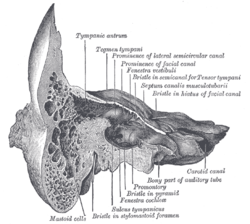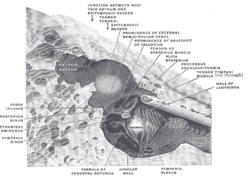Mastoid antrum
| Mastoid antrum | |
|---|---|
 Coronal section of right temporal bone. ("Tympanic antrum" labeled at upper left.) | |
 The medial wall and part of the posterior and anterior walls of the right tympanic cavity, lateral view. ("Mastoid antrum" labeled at upper left, in dark circle.) | |
| Details | |
| Identifiers | |
| Latin | antrum mastoideum |
| TA | A15.3.02.028 |
| FMA | 55711 |
The mastoid antrum (tympanic antrum, antrum mastoideum, Valsalva's antrum) is an air space in the petrous portion of the temporal bone, communicating posteriorly with the mastoid cells and anteriorly with the epitympanic recess of the middle ear via the aditus to mastoid antrum (entrance to the mastoid antrum). These air spaces function as sound receptors, provide voice resonance, act as acoustic insulation and dissipation, provide protection from physical damage and reduce the mass of the cranium.
The mastoid air cell system is a major contributor to middle ear inflammatory diseases.[1]
Additional images
 Left temporal bone showing surface markings for the tympanic antrum (red), transverse sinus (blue), and facial nerve (yellow).
Left temporal bone showing surface markings for the tympanic antrum (red), transverse sinus (blue), and facial nerve (yellow).
References
- ↑ Koç, Ahmet; Karaaslan, Osman; Koç, Turgay (2004). "Mastoid air cell system" (PDF). Otoscope. 4: 144–54.
External links
- Anatomy figure: 30:02-01 at Human Anatomy Online, SUNY Downstate Medical Center - "Illustration of the continuity of the nasopharynx with the middle ear cavity via the auditory tube."
This article is issued from Wikipedia - version of the 5/23/2015. The text is available under the Creative Commons Attribution/Share Alike but additional terms may apply for the media files.